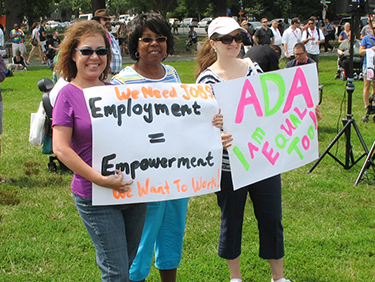 On July 26, 1990, the Americans with Disabilities Act legalized protections against discrimination for people with disabilities. The law expanded accessibility in transportation and infrastructure and widened opportunities in the workforce for people with disabilities. Barriers still remain, however.
On July 26, 1990, the Americans with Disabilities Act legalized protections against discrimination for people with disabilities. The law expanded accessibility in transportation and infrastructure and widened opportunities in the workforce for people with disabilities. Barriers still remain, however.
As the law reached its 33rd anniversary this summer, The Nation’s Health spoke with Vijay Vasudevan, PhD, chair of APHA’s Disability Section, about today’s priorities.
How has the ADA changed life for people with disabilities over the past three decades?
In my opinion, the biggest achievement of the ADA was that it put people with disabilities on the same level and stature as other marginalized groups, like racial minorities, the LGBTQ+ community and women.
Because it was a civil rights law, it enabled people with disabilities to participate in their communities through work and education, but a lot more is still needed because they still experience barriers today, from physical to environmental to the policy level.
Do you see the ADA as a living document? What would you like to see happen next on the law?
I do think the ADA is a living document. A lot of the outcomes have been impactful, and it has to be flexible given the nature of the day.
I would like to see a greater emphasis on the intersectionality of disability with other demographics, like race and gender. For example, a Black disabled person who is queer is going to have a very different experience in their day-to-day life than a disabled white male would. The ADA and other civil rights laws can work together to really start addressing life at these intersectionalities.
What issues would you like to see public health professionals address?
The area that I would like to see greater emphasis is around voting rights access for disabled people. This especially comes with some states implementing restrictions on voting by mail or other areas to limit access to support for voters. It really impedes on the rights of the citizens.
It has gotten to the point where the American Medical Association has identified that voting rights directly impacts the social determinants of health. It would be really great to see public health do something similar to really take this on and identify voting rights as a major driver of health outcomes for people with disabilities.
What are some of the priorities for APHA’s Disability Section?
We’re really working on promoting accessibility and inclusion across everything that APHA does, starting from the Annual Meeting. Because it is the biggest, most visual thing that everyone can do — making sure as many presentation rooms as possible are accessible and inclusive for people, trying to make sure there’s a lot of navigation put in place for people with disabilities to know where things are and how to get around.
Disability rates tend to be higher in rural areas of the U.S. than in urban. How has the ADA changed life for people with disabilities over the past three decades?
In my opinion, the biggest achievement of the ADA was that it put people with disabilities on the same level and stature as other marginalized groups, like racial minorities, the LGBTQ+ community and women.
Because it was a civil rights law, it enabled people with disabilities to participate in their communities through work and education, but a lot more is still needed because they still experience barriers today, from physical to environmental to the policy level.
What gains do you hope to see for workers with disabilities?
The lower unemployment rate is likely a result of a lack of accommodations or policies in place that would make a person with a disability lose benefits if they earn too much money. Some policies have really been pushing toward the elimination of the subminimum wage for people with disabilities, where they’re paid significantly less, like pennies to the dollar from the general community.
Additionally, I think one of the other areas where we’ve seen a lot of increased opportunities has been remote work and telework opportunities. It really enables people to work where they’re at and really contribute to society.
How did the COVID-19 pandemic impact people with disabilities?
As you’re aware, people with disabilities experienced worse health outcomes at every stage of the pandemic, from being housed at congregate sites to nowadays with people getting long COVID.
We are seeing how many of those people have long-term disabilities because of that. Or how students with disabilities are impacted by not being able to go in person to their schools to receive services and support that they need. If they could not physically go to school and had to go to school remotely, they were not able to benefit from the in-person education opportunities that the other students were able to.
We’re going to see that disparities are going to continue for people with disabilities because of the pandemic. It would be really great to see if we could get all the civil rights laws pushed up and sup- ported — getting better access to voting rights and really just strengthening those current laws and allowing people with disabilities to be viewed at the same level as everyone else.
For more information on the anniversary of the ADA, visit www.ada.gov. This interview was edited for style, clarity and length.
Picture caption: People support the United Nations Convention on the Rights of Persons with Disabilities on the National Mall in Washington, D.C., in 2014. (Photo Courtesy Andrew Jones/APHA via Flickr Creative Commons)